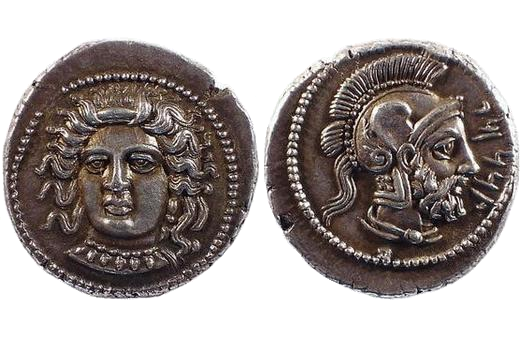
about ancient nomos
Ancient Nomos Art is a museum of galleries exhibiting ancient coins and ancient mint maps. The coin gallery displays the diverse art and history of hand-crafted ancient Greek, Roman, Byzantine, Persian and Medieval coinage. The ancient mints mapping gallery features Greek, Roman, Byzantine, Asia Minor and Medieval mint city regions and territories. Visitor's are welcome to explore, study and enjoy Ancient Nomos Art.

Persian Cilicia – 378 BC
Tarsos, Persia
From Ancient Galleries

Obverse: Goddess Arethusa facing slightly left wearing single-pendant drop earring and necklace of pendants with hair band over her forehead, all in beaded borders.
Reverse: Head of bearded Warrior facing right, wearing crested Athenian helmet.
LEGEND SYMBOLS
Obv. Female head facing slightly left, (styled after Arethusa of Kimon), wearing single-pendant drop earring and necklace of pendants with a hair band over her forehead; beaded border. Rev. Head of bearded warrior (Ares?) facing right, wearing crested Athenian helmet adorned with tendril and with raised ear flap; legend in Aramaic script to right, all within beaded border.
Persian King’s ruled the diverse populations of Cilicia for centuries before Alexander III Hellenized the region. Typically, the King elected satrap’s to govern regions of Persia and allowed these ruling officials to issue coinage. This silver stater is thought to be issued under Datames, the son of Kamisares, who served as a Persian king’s bodyguard before becoming satrap of Cilicia and Cappadocia in 384 BC. His early military successes resolving rebel revolts in Lydia and Thyos gave the Persian King confidence to place him in command of the 2nd war against Egypt, along with Pharnabazos and Tithraustes, satrap of Caria. This coin was struck at the Tarsos mint in Cilicia (also see Cilicia 361 BC), and reflects the blending of both Persian and Greek influences. The obverse portrays a forward facing woman with her head turned slightly left, as curls of hair radiate outward to animate her beauty. The design is thought to be modeled after the Magna Grecian engravings by the artist Kimon. She is seen wearing single-pendant drop earrings, necklace of six individual pendants with her forehead revealed by a gilded hair band which delicately restrains the flowing hair. The coin’s reverse depicts the bust of a fully bearded warrior, thought to be Ares, facing right wearing a cloak with pendant. He is wearing a crested Athenian helmet adorned with a tendril, visor and raised ear flap. The Arameic legend is inscribed to the right and translates, “Tardamu,” a Greek form of Datames name. Datames was eventually removed from his successful Egyptian command and satrapy by a jealous King, forcing Datames to become an independent ruler of Cilicia. The revolts by Datames and other Cilician satraps disintegrated the regions Persian governing system, which soon allowed the struggle for power by Mithradates, satrap of Phrygia, to have Datames assassinated in 362 BC.
DOCUMENTATION
Value: Stater. Metal: AR Silver. Weight: 10.76 grams. Mint: Tarsos. Date: circa 384-362 BC.
Struck 378-372 BC under Tarkumuwa (Datames), Satrap of Cilicia and Cappadocia.
Attribution: ANS Museum Notes 31 (1986), Plate 2; SNG Levante 78; SNG Paris 265 (same dies); BMC Lycaonia pg. 167, 29 var. (AM on helmet); SNG Cop. 278; SNG von Aulock 5939; Casabonne Series 1; Moysey 4; NFA 1987, 226.
Legend, Documentation and Attribution
